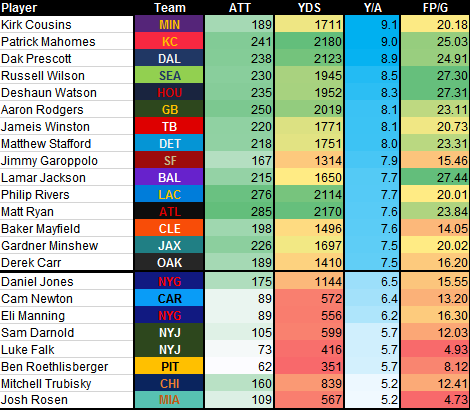Antonio Losada provides key fantasy football analysis for quarterbacks and Next Gen data, to help fantasy owners make the best lineup and waiver wire decisions.
Okay, folks, I'm about to bring you bad news. If you're reading this it is because you're trying to get an edge over your league mates to beat them this weekend. That means you're here to get informed on what to do and how to tackle your week's most pressing decisions. The bad news: these will be your final guesses of the first half of the season. It's time to panic because in just mere days we'll be counting down the days to season's end instead of looking forward to another week of football. But hey, today is not the time to get depressed. Why? Because in this article we have new insights from everyone's favorite source, NFL advanced stats! More than anything the reason to be cheerful is that I'm back to discuss the most important position in all of the sports! If that isn't great, I don't know what is...
To gain the biggest edge in your fantasy football league, it's necessary to understand how to apply the advanced statistics being used in every sport nowadays. Back in the day, it was all about wins and losses, passing yards, and touchdowns scored. It is not that those stats are worthless, but they don't offer enough to the savvy analysts. While football is yet in its infancy in terms of analytics compared to baseball, the evolution the sport has seen lately in those terms is notable.
Each week, I'll be tackling NFL's Next Gen Stats, bringing you data from the just-completed week's games with notable takeaways you should consider when assessing fantasy players for the upcoming week. In case you're new to the series, or Next Gen Stats altogether, I recommend you read our preseason primer. Now, let's get to the data!
Be sure to check all of our fantasy football rankings for 2025:- 2025 fantasy football rankings
- Running back (RB) rankings
- Wide receiver (WR) rankings
- Quarterback (QB) rankings
- Tight end (TE) rankings
- Defense (D/ST) rankings
- Kicker (K) rankings
- FLEX rankings
- Dynasty rankings
So, What Is The Matter With Quarterbacks?
First of all, I have to thank those of you that have read this series from the first column to the last one. And most of all I have to thank those who read last week's entry about running back advanced metrics and came to me with tons of positive feedback. Why is that? Well, for one, I appreciate you taking a few minutes to read this super long thing. And strictly in relation to this week's column, the fact that you liked and found last week's one interesting made me think about re-adapting it this week to quarterback-related metrics. So here we are, and I hope you enjoy this one too!
During the last two columns in which I discussed quarterbacks, I already covered most of NGS metrics. If you remember, we went through "true" Completion% (COMP%) and "expected" Completion% (xCOMP%) rates to explore the difference between them and who was over- or under-performing what the numbers said. After that, I decided to go a step further and tackle a little more advanced (or at least, less fantasy-related) metrics such as Time to Throw (TT), Aggression (AGG%), Completed/Intended Air Yards (CAY/IAY) and Air Yards Differential (AYD).
We can take interesting information from each and every metric available to us, but as we saw with running backs just a few days ago, not every metric should be weighted the same when assessing players in our fantasy leagues. That is why today I'm going to go straight to the point and provide the most meaningful information about the metrics available at NFL's Next Gen Stats QB leaderboard. That way, you will be able to know which of them correlate more with quarterback success and fantasy points.
Through seven weeks of games, almost every team has a solid situation at quarterback. There are cases that don't follow the rule, but those are the least. In fact, as I'll be using NGS stats and thresholds (min. 53 pass attempts), some of the least-used QBs to this point won't make it to this column (notably Ryan Tannehill, Devlin Hodges, Drew Brees, and Matt Moore) so we won't have to care about those.
Firstly, I ran a few simple correlation calculations to see how metrics and fantasy points relate and how strong those relationships are. The resulting numbers range from negative-1 to positive-1. Zero means no correlation. A negative value means an inverse relationship (when one metric goes up, the other goes down), and a positive value means a direct relationship (when one metric goes up, the other goes up too). Here are the metrics offered by the NFL to measure quarterback performance, and how they relate to Fantasy Points:

As a quick intro to correlation: experts more or less agree on correlations being significant only if the value surpasses the +/-0.7 threshold. As you can see, only three quarterback metrics do that here and they are the most obvious and most related ones to fantasy points: attempts, yards, and those two combined in Yards per Attempt. It was to be expected. However, that doesn't mean the rest of the stats aren't important (in fact, anything around +/-0.5 shows a good enough relation as to be taken seriously). They are important, only to a lesser degree, and should be taking into consideration when looking at QB data. Sports are not an exact science, so it is impossible to have stats perfectly align week to week. It makes it harder for us fantasy owners to play the game, but it also makes it fun!
Instead of giving a quick takeaway of each metric, I'll do it at the same time as I provide you with the leaders and trailers of each category so you can take both the main takeaway from each stat and also see some real-life examples to make sense of it. I'll include the fantasy points of each player showcased to provide a better context for comparison.
"TT" Translated to Fantasy Football
Leaders and trailers:
Impact on fantasy football points (38%): Although not overly strong, the relation between the time a QB takes to throw and the points he gets is sufficiently high to take at least a little bit into consideration. Don't take this metric as the holy grail to win you the league, but when in doubt between who to pick to be your quarterback, looking at these numbers can be a deal-breaker in some cases.
Important takeaways:
- The most straight forward thought that comes from this stat is related to how fantasy football works, which comes down to points based mostly on yards and touchdowns. More time to throw means more time to let routes develop and bigger yardage gains for fantasy quarterbacks. And that is where the money is.
- A quick glance at the list above this text makes the prior point clear. Only two players are averaging fewer than 2.6 TT and still getting 19-plus points per game, while also only two are averaging more than or 2.87 TT and getting less than 20 points per game.
- There is no stat for this but as you can see in the small list above, pocket passers sit at the top while scramblers and risk-takers are at the bottom. Tom Brady, Joe Flacco, and Jimmy Garoppolo are not going to buy time by moving around: they'll settle for what they're given and go with it. The opposite happens with the bottom half. Baker Mayfield, Russell Wilson, and Aaron Rodgers won't have a problem extending plays as much as possible dodging rushers until they find what they want.
- Don't over-rely on TT, but use it as an interesting data point when deciding between two quarterbacks (for example, if you're streaming the position). Look for the ones who are able to extend the play, either because of their own abilities or because they play behind great offensive lines.
"CAY/IAY & AYD" Translated to Fantasy Football
Leaders and trailers:
Impact on fantasy football points (CAY 61% / IAY 38% / AYD 30%):
- CAY: Although the Completed Air Yards a quarterback throws per game doesn't quite reach the 70% threshold introduced earlier as to consider it truly meaningful, it's really close it and therefore CAY explains an important part of fantasy production. It makes sense. The more yards a passer completes, the more points he'll get. As simple as that. The explanation for the lower relationship with fantasy points in comparison to the raw "Yards" metric is that Air Yards do not account for Yards After the Catch gained by the receivers.
- IAY: The more yards a quarterback goes for, the more chances he gets big gains and more fantasy points. The relation is not great but does show some useful information. The problem with big throws is that they carry more risk to them, so IAY should only be used as a deciding factor when comparing two very similar quarterbacks in the rest of their stats.
- AYD: The difference between the completed and intended Air Yards doesn't say much about how good or bad a quarterback is and shouldn't be considered in fantasy. Just think of it for a second. One quarterback can complete passes for 10 yards on average while averaging 20 yards downfield on attempts. Another one can complete the same amount, only at 5 yards while averaging an attempt distance of 15. The difference is the same (10 yards), but the first one will produce more than the second one. This makes the metric not very reliable.
Important takeaways:
- Always keep in mind that CAY will be lower than Y/C no matter what. The former only looks at production by the quarterback's own passing abilities, while the latter factor the receivers running after the catch in (as the quarterback's total yards account for both Air Yards and Yards After the Catch).
- Related to the last point, when studying quarterbacks it is interesting to look at the difference between what the QB is generating himself and how his receivers are helping them instead of just focusing on CAY in isolation. An average quarterback with a great group of receivers will be helped rack up points even if he throws for fewer yards than a great QB.
- Although they have a weaker relation with fantasy points, IAY tells us more about quarterback styles of play. Those with the largest IAY tend to be better fantasy bets as they are either good QBs or bring a boom-or-bust profile that will compensate over time.
- A quarterback with a very low IAY is always going to be relying on the work of his receivers and has his upside cut in fantasy (in fact, only three of the players averaging fewer than eight air yards per throw are currently scoring 20-plus fantasy points per game).
- On the other hand, nine of ten players with at least 9.0 IAY are posting 20-plus fantasy points per game through Week 7.
"AGG%" Translated to Fantasy Football
Leaders and trailers:
Impact on fantasy football points (negative-27%): Aggressiveness (defined as the rate of passing attempts thrown into tight coverage) has a much stronger relation with COMP% (negative-48%) than with fantasy production. For us fantasy owners this metric can almost be disregarded.
Important takeaways:
- Excluding those at the very bottom of the AGG% leaderboard (Aaron Rodgers, Tom Brady, Matt Ryan, Patrick Mahomes), there is really not a strong relationship to consider tight throws impact in what a quarterback produces in fantasy football. As you see on the top half, things get much messier with point averages spreading all over the place.
- In fact, if we remove the bottom-six players from the table above and re-calculate the correlation, it drops down to a ridiculous negative-15%, totally insignificant.
- As a rule of thumb, lean toward less aggressive passes on your average decisions. But don't make this metric the end-all-be-all of your choices, not even a very small amount.
"ATT/YDS & Y/A" Translated to Fantasy Football
Leaders and trailers:
Impact on fantasy football points (ATT 74% / YDS 82% / Y/A 76%):
- ATT: As with running backs and receivers, volume is key for fantasy success. The more passes a quarterback attempts, the more chances he'll get at racking up bigger numbers. I don't want my real-life QB to throw the ball no matter what in nonsensical ways, but in fantasy? Give me all the throws he can take.
- YDS: And obviously, Yards take where we left it with Attempts and add to it. They are the most comprehensible stat for everyone and the one (other than touchdowns, left out of this study for obvious reasons) that best relates to fantasy production. Considering this metric includes both Air Yards and Yards After the Catch, it is reasonable that it relates better to fantasy points than Air Yards alone.
- Y/A: Not a lot more to add here. You need to look for quarterbacks than go for big gains on average by themselves and that have reliable receiving corps they can throw the ball to.
Important takeaways:
- I'm going to cheat and almost copy what I wrote about running back attempts here: volume is key. If your quarterback is not throwing the ball, he will not have enough chances to rack up points and you'd be betting on a few huge plays for him to compensate and give you a good performance. Either you have someone like Lamar Jackson (who can run for points and add value that way), or you won't do much with a low-volume quarterback.
- As you can see, Kirk Cousins is the poster boy of efficient play and good surrounding weapons. He isn't throwing a lot of passes but he's still putting up an average of 20 points per game while having the highest Y/A. Daniel Jones, on the other hand...
"COMP%/xCOMP% & +/-" Translated to Fantasy Football
Leaders and trailers:
Impact on fantasy football points (COMP 45% / xCOMP negative-16% / +/- 57%):
- COMP%: Completion rates are pretty close to the 50% threshold introduced earlier, but they fall short for obvious reasons (although they are a good enough indicator of QB-fantasy talent). The strong side of the relationship comes from the fact that on average, good quarterbacks are both going to complete passes on a higher ratio and to put up big points. The weak side, though, reminds us that even a boom-or-bust, gunslinging thrower, can make up for a lot of incompletions with just a bunch of huge completions.
- xCOMP%: Expected Completion rates work on what should have happened, instead of what has happened. That is why they have virtually no relation to fantasy outcomes. xCOMP% works in an alternate universe while fantasy points work in this one. Look at this metric when analyzing quarterbacks as a whole, but don't use it as-is for your fantasy decisions.
- +/-: As plus/minus gets back to the "real world", it relates much better with fantasy points. In fact, it is the one that holds the strongest relationship. Quarterbacks over-performing (given the expectations) are doing so in real life and therefore are getting better fantasy numbers. The bigger the overperformance, the greatest the chances someone is having quite a fantasy year.
Important takeaways:
- The table above, and the metrics it includes, is very straightforward. The quarterbacks with high completion ratios are the best in the league (Matt Ryan, Dak Prescott, Deshaun Watson, Russell Wilson). However, there are those who are keeping their fantasy production high taking safe options most of the time and limiting their mistakes (Derek Carr, Kirk Cousins, Jimmy Garoppolo).
- That second statement becomes even clearer if looking at the xCOMP% leaderboard. As that metrics work on what happened in similar past situations, "safe" plays are favored and awarded bigger completions rates than riskier ones that ultimately turned out good for players in real life. That is why the xCOMP% leaders include names such as Derek Carr, Teddy Bridgewater, and Mitchell Trubisky.
- At the end of the day, the plus/minus metric is what matters most between these three. It tells us who is performing better than has historically been done, and it shows. Dak Prescott, Russell Wilson, and Kirk Cousins are all playing (yes, in very different ways) above their expectations. Josh Rosen, Baker Mayfield, and Jared Goff, though, are disappointing both fans and fantasy owners each weekend. There is no arguing with that.
That's it for today. Until we meet again next week, don't get too mad at the bye weeks leaving four teams out of the schedule, try to find the best free agents on your leagues' player pools, field the most productive teams you can, and win the weekend with all of your squads!





 RADIO
RADIO





























